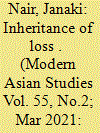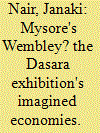|
|
|
Sort Order |
|
|
|
Items / Page
|
|
|
|
|
|
|
| Srl | Item |
| 1 |
ID:
177983


|
|
|
|
|
| Summary/Abstract |
In 1845, the banker Damodar Dass of Srirangapatna loaned a large sum of money to Maharaja Krishnaraja Wodeyar III of Mysore. For the next seven decades, until the unpaid debt was turned into public charity, the multiple claims of Damodar Dass's heirs to this inheritance led the colonial state and the Mysore government (especially after 1881) to form a substantial archive. Occupying the foreground of this archive were the legal dilemmas posed by the transition from direct to indirect British rule in Mysore, involving the fate of kingship, debt, reciprocality, and masculine honour. Other legal dilemmas concerned the relationship between scriptural and customary law and, in particular, the portability of customary law between regions that were unevenly exposed to Anglo-Indian legal regimes. The claims also reveal the important ways in which a new moral order was being shaped as the relationship between the colonial regime and the princely state (or later its bureaucracy) was defined and the status of four female heirs was called into question. Additionally, the archive has the potential to disturb the univocality of this statist discourse. A third narrative may be uncovered that involves the ‘small voices of history’. What hopes did this era of profound transformation hold for women of the non-domestic sphere? What, moreover, can the women in these archives be heard to say about the truth of their times?
|
|
|
|
|
|
|
|
|
|
|
|
|
|
|
|
| 2 |
ID:
126138


|
|
|
|
|
| Publication |
2013.
|
| Summary/Abstract |
Most scholarly works on exhibitionary practices of the nineteenth and twentieth centuries have focused on the meaning and importance of display, and the cultural bases, and indeed biases, that supported various inclusions and exclusions. The exhibition has usually formed part of a larger narrative of new rituals that were enacted in the modern period to serve, variously, imperial, market or patriotic objectives. Can the persistence with which the Princely Mysore state organized its Dasara Exhibition from 1907 until well after independence be understood solely within these frames? In both its choice of location and its timing, the Dasara Exhibition was organized with dogged insistence, despite its obvious failures. This can only be understood in relation to the larger changes that were envisaged for the economy of the region, as the state attempted to build a supplement, even an alternative, to the princely splendour and pomp that was on conspicuous display. This paper looks at the subtle changes and shifts that occurred during the first half of the twentieth century in exhibitionary practices as they related to both real and envisaged changes within the economy that the Mysore bureaucracy was obliged to bring into being.
|
|
|
|
|
|
|
|
|
|
|
|
|
|
|
|
|
|
|
|
|